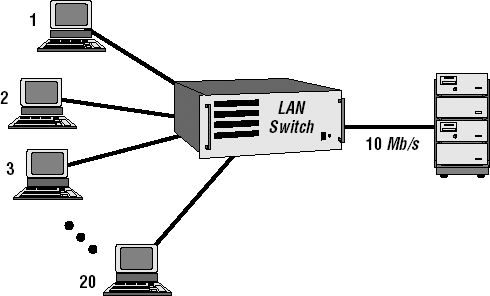13.1. Why Priority?
What's wrong with being fair? Why should some users or applications receive preferred treatment?[] If the performance of the catenet is acceptable for all applications under all traffic conditions, then there really is no reason to invoke priority mechanisms. This is both the desired and the typical case. Because LAN bandwidth and switch capacity are relatively inexpensive, overprovisioning is a common and acceptable solution to most LAN performance concerns. Of course, application needs increase over time, and it is impossible to overprovision to the extent of supporting worst-case transient situations. It is important to remember that Priority operation adds complexity to switches; there is no need to pay for this complexity unless there is an application performance benefit to be gained.
[] In particular, why is my traffic always afforded low priority and everyone else's given precedence??!!
Figure 13.1. Inadequate capacity

Consider the following situations:
The catenet (or some subset of it) cannot handle the steady-state traffic load offered by the attached users and applications. This situation can occur if some link or switch in the catenet has inadequate capacity to support the desired application data flows. In the situation depicted in Figure 13-1, if the 20 workstations shown each move an average of 5 Mb/s of data to the server during an eight-hour ...
Get The All-New Switch Book: The Complete Guide to LAN Switching Technology, Second Edition now with the O’Reilly learning platform.
O’Reilly members experience books, live events, courses curated by job role, and more from O’Reilly and nearly 200 top publishers.

